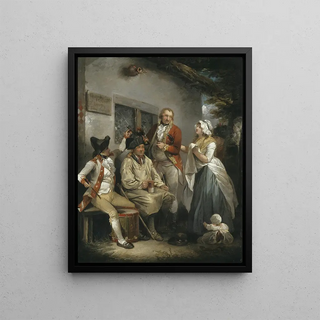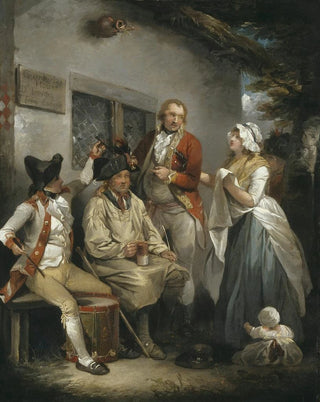Art print | Trepanation of a recruit - George Morland


View from behind

Frame (optional)
In the vast landscape of art history, certain works stand out for their ability to capture moments of tension and reflection. "Art print Trépanation d'une recrue - George Morland" is one of these iconic pieces that, through its poignant realism, immerses us in the complex world of 18th-century medical practices. This piece, depicting a scene where a young soldier undergoes a trepanation, illustrates not only the challenges of medicine at the time but also how art can serve as a mirror to our collective anxieties. Morland, with his unparalleled talent, manages to evoke an atmosphere that is both dramatic and captivating, inviting viewers to ponder the pain and sacrifice inherent in the human condition.
Style and uniqueness of the work
George Morland's style in "Art print Trépanation d'une recrue" is characterized by striking realism and meticulous attention to detail. Every element of the composition, from the expressions of the characters to the medical instruments, is carefully designed to convey a palpable emotional intensity. Light plays a crucial role in this piece, highlighting the tense faces of the protagonists while casting the rest of the scene into an ominous shadow. Morland does not merely depict a medical scene; he captures a moment of human vulnerability, where life and death coexist inexorably. This choice of subject, bold for its time, reflects the artist's desire to explore themes often avoided, making the work even more striking and memorable.
The artist and his influence
George Morland, born in 1763, quickly established himself as one of the most influential artists of his era. His work, marked by a deep understanding of human nature and a capacity to portray daily life with unique sensitivity, left an indelible mark on British painting. Morland drew inspiration from social realities and struggles of his time, and "Art print Trépanation d'une recrue" is a perfect example. His innovative approach and commitment to realism paved the way for many subsequent artists who sought

Matte finish

View from behind

Frame (optional)
In the vast landscape of art history, certain works stand out for their ability to capture moments of tension and reflection. "Art print Trépanation d'une recrue - George Morland" is one of these iconic pieces that, through its poignant realism, immerses us in the complex world of 18th-century medical practices. This piece, depicting a scene where a young soldier undergoes a trepanation, illustrates not only the challenges of medicine at the time but also how art can serve as a mirror to our collective anxieties. Morland, with his unparalleled talent, manages to evoke an atmosphere that is both dramatic and captivating, inviting viewers to ponder the pain and sacrifice inherent in the human condition.
Style and uniqueness of the work
George Morland's style in "Art print Trépanation d'une recrue" is characterized by striking realism and meticulous attention to detail. Every element of the composition, from the expressions of the characters to the medical instruments, is carefully designed to convey a palpable emotional intensity. Light plays a crucial role in this piece, highlighting the tense faces of the protagonists while casting the rest of the scene into an ominous shadow. Morland does not merely depict a medical scene; he captures a moment of human vulnerability, where life and death coexist inexorably. This choice of subject, bold for its time, reflects the artist's desire to explore themes often avoided, making the work even more striking and memorable.
The artist and his influence
George Morland, born in 1763, quickly established himself as one of the most influential artists of his era. His work, marked by a deep understanding of human nature and a capacity to portray daily life with unique sensitivity, left an indelible mark on British painting. Morland drew inspiration from social realities and struggles of his time, and "Art print Trépanation d'une recrue" is a perfect example. His innovative approach and commitment to realism paved the way for many subsequent artists who sought






